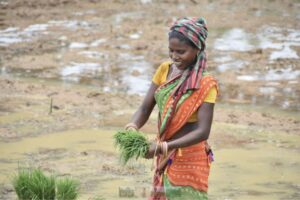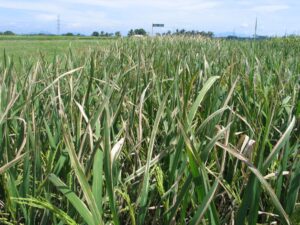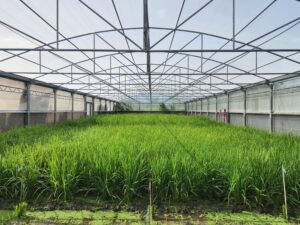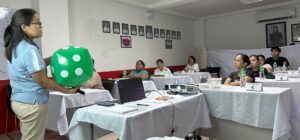
“No farmer must be left behind” was the challenge addressed to 1,500 scientists and delegates, hailing from 69 countries, who are here in Bangkok to attend the 4th International Rice Congress (IRC2014).
“This call to action adds all the more to our resolve to continue the research on Golden Rice, a potential new food-based approach to help fight vitamin A deficiency (VAD), a form of hidden hunger,” said Dr. Violeta Villegas, Golden Rice project coordinator at IRRI.
IRRI remains steadfast because, in addition to farmers, “We also believe that no rice consumer should be left behind, especially women and children,” added Villegas.
Hidden hunger is a pervasive and persistent problem affecting more than 2 billion people worldwide. Specifically, 190 million preschool children and 19 million pregnant women are still vitamin A-deficient globally. VAD results from a lack of sufficient vitamin A in the diet. Various programs on dietary diversification, fortification, and supplementation have made headways in combating VAD, yet gaps still exist.
In the Philippines, vitamin A deficiency still affects approximately 1.7 million children (15.2%) aged 6 months to 5 years while in Bangladesh, more than half of preschool and school children are affected. In Indonesia, 14.6 % of children under five experience sub-clinical deficiency of vitamin A.
It is true that there are many vegetables and fruits that have high vitamin A content. However, many of these foods are seasonal and therefore scarce, unavailable, or too expensive, especially in the far fringes of society. In poor urban areas, limited access to land for the production of food is another challenge. In the Philippines, only 2 out of 10 children 6-23 months achieve the minimum dietary diversification score. Hence, in reality, access to diverse, nutritious, and fresh food is a challenge for the poor.
Current vitamin A supplementation programs are prone to limitations in funding and fluctuations of coverage. Fortification of staple and processed foods faces numerous challenges in implementation and must be mandatory and subsidized to reach those in need.
Golden Rice can be a potential sustainable complement to alleviating VAD. The initial investment in developing and testing Golden Rice can generate new, healthier rice varieties that farmers can grow for years to come. Because most rice is consumed near to where it is grown, it is envisioned that there will be low distribution costs for Golden Rice.
Some groups are keen on stopping the deployment of Golden Rice by raising speculations that a) it will threaten food security by contaminating traditional rice varieties, b) it is being forced to farmers and consumers as a complete solution to VAD, and c) its lengthy development shows that it is a false solution to VAD. The use of genetic engineering, instead of marker assisted selection, in the development of Golden Rice is being criticized.
“To answer the first point, it is incorrect to speculate that Golden Rice will threaten food security,” said Dr. Villegas. It is unlikely that Golden Rice will contaminate traditional or conventional rice varieties because rice is typically self-pollinated and cross-pollination is uncommon. Furthermore, the Golden Rice trait does not confer any selective advantage, it does not make the plant stronger nor weaker than others. The wild rice species do not cross readily with cultivated rice varieties even if they are growing close together and flower at the same time because of incompatibility.
On the second point, Dr. Villegas emphasized that IRRI and its partners have never claimed that Golden Rice is the silver bullet that will totally solve VAD. We have always emphasized that Golden Rice will be a complement, not a replacement, to the current strategies in the fight against VAD. Eating diverse diets, fortification, and supplementation must continue. But where and when these are not available or sustainable, Golden Rice can help address VAD.
Further, like all other technologies developed by IRRI, Golden Rice will be offered as an option to farmers and consumers. Farmers know how to choose what seeds that will work best in their specific location, while consumers have the same decision-making capability in their purchases. When it becomes available, the decision to plant or consume Golden Rice is left to each individual.
Dr. Villegas answered the third point by saying that the R&D on Golden Rice is still ongoing because we want to ensure that it will bring benefits to those who will plant it, and those who need it most. It should be noted that IRRI’s high-yielding varieties and farming technologies have enabled increases in production per land area for farmers and made rice generally more affordable for consumers.
The increased yields obtained through IRRI technologies can help rice farmers to free up land area to raise other nutritious crops and animals. As rice becomes less expensive for consumers, households have more money to spend on other things including more micronutrient and protein-rich foods. For Golden Rice, the research is still ongoing so that it will have comparable yield as local high-yielding varieties. Hence, it can further enable farmers and consumers to obtain a diversified diet, which is one way to address VAD.
Lastly, it should be emphasized that IRRI applies genetic engineering only when the beneficial traits needed cannot be found within the rice gene pool. “Marker assisted selection is indeed a useful tool for both conventional and modern breeding. However, surveys of rice germplasm around the world failed to identify any variety that contain significant amounts of beta carotene, so conventional breeding programs could not be used to develop Golden Rice.”
As a rule of thumb, plant breeders in both public research institutes and private companies use genetic engineering only in the following situations: 1) the gene of interest is not found within the crop gene pool, 2) if found in the gene pool, transfer will be difficult due to incompatibility and other breeding problems or 3) the transfer of the gene will take a long time as in the case of perennial crops like coconut.
Therefore, Golden Rice was developed using genetic modification, using genes from maize and a common soil microorganism that together produce beta carotene in the rice grain. The unique advantage of genetic modification lies in its ability to incorporate novel genes with useful traits into new rice varieties. These include genes from plants and organisms unrelated to rice that could not be transferred using other breeding methods. This is possible because all genetic information is stored in the DNA – which is the common building block of all living things. Genetic modification can also greatly increase the accuracy of incorporating only those genes for the needed trait into a new rice variety.
Research on Golden Rice continues to be motivated by its potential contributions to solving the global problem of VAD that afflicts more than 200 million people, especially women and children. As a responsible research institution, IRRI is committed to offer high quality options for farmers and consumers, none of whom should be left behind.









